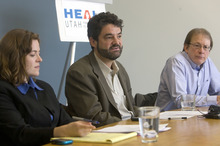This is an archived article that was published on sltrib.com in 2013, and information in the article may be outdated. It is provided only for personal research purposes and may not be reprinted.
Utah air-quality regulators on Wednesday approved a draft plan to clean up Wasatch Front air in compliance with federal standards by the end of 2019.
Improvements to motor vehicles and gasoline and new regulations on industry and small businesses are expected to help Utah's urban corridor achieve acceptable concentrations of fine particulate, the air pollutant known as PM2.5, according to Stephen Sands, chairman of the Utah Air Quality Board.
"The good news from today is the draft plan does show that control measures are going to be sufficient to bring us into attainment," said Sands, an executive at Kennecott Utah Copper.
In 2009, several Wasatch Front airsheds fell out of compliance with thresholds for PM2.5, the gunk that blankets the Salt Lake and Utah valleys during winter inversions. Attainment will require these airsheds to be within the threshold, set at 35 micrograms per cubic meter of air, at least 358 days a year, according to Bryce Bird, director of the Division of Air Quality (DAQ).
Currently the front is in compliance on average 347 days annually, or 95 percent of the time.
The board's vote to advance the draft statewide implementation plan, or SIP, opens a 30-day public comment period and a series of public hearings next month with final approval expected in December.
Environmental health advocates were pleased the state is finally moving a plan forward after four years of study, but wondered if it can't demand more from industrial "source point" polluters.
"It's dismaying that during the period Utah is looking to cut emissions, they are allowing industry to increase its overall emissions. The vast majority of the cuts that will allow Utah to meet its goal will be from federal actions, primarily cleaner gasoline and cleaner cars," said Matt Pacenza, policy director of HEAL Utah. "They are taking steps in the right direction but we and others will scrutinize this analysis to see if industry is reducing emissions all it can."
Utah air-quality scientists and regulatory staff have been working on the plans ever since the federal government announced the tighter controls on microscopic soot.
The goal has always been to cut emissions enough to avert a crackdown by the U.S. Environmental Protection Agency that might choke development and transportation funding for the state's most populated counties.
Most other areas of the nation with PM2.5 pollution problems submitted plans last year. Among them was northern Utah's Cache Valley, which adopted a controversial emissions-testing program to cut its biggest source of winter pollution: dirty car and truck emissions.
As recently as May, after more than three years of looking for pollution solutions, the air-quality office found it still needed to reduce pollution an additional 10 percent to meet the EPA standard, both in Utah County and in the five-county area that is officially known as the Salt Lake City non-attainment area.
The draft plan will cut emissions for the Salt Lake area, which includes Tooele and Box Elder counties, 22.3 tons per day by late 2014 and by 64.5 tons by 2019, when officials hope to achieve attainment, Bill Reiss, a DAQ environmental engineer, told the board.
"Most of the residents in the valley will be breathing cleaner air before 2019," Reiss said. Aggregate emissions from vehicles and other mobile sources will be cut by half, from about 170 tons to 85 per day, thanks in part to federal regulations on cars and fuels, not from reductions in driving.
Last summer, the Air Quality Board approved nearly two dozen regulations aimed at particulate reductions from small businesses and everyday life.
They included limiting the fumes of hairspray and other personal-care products, along with lower-fume paints and cleaning up smoke from commercial grills.
Air-quality officials went back to the computers, to the public, and to the bargaining table in search of even more reductions. With this new plan, they think they've persuaded key industrial polluters to do more than they've ever done before, with smarter operations and the best-available equipment.
Still, regulators could not guarantee the plan will get Utah air into compliance with PM2.5 standards.
"I would feel better if we had more headroom. We scraped the bottom of the barrel to get our emissions down," Reiss said. "I don't know what we can do to provide a significant margin to hedge against that uncertainty. We're out of bullets at this point."
Clearing the air
The Utah Air Quality Board released a draft plan to get the Wasatch Front into compliance with federal standards for soot and other fine particulates. The public may comment submit comments on the plan and speak at hearings next month. (The times and addresses have not been finalized.)
Oct. 8 • Ogden
Oct. 9 • Provo
Oct. 15 • Salt Lake City.
The board will vote to approve the final version at its Dec. 4 meeting before submitting it to the U.S. Environmental Protection Agency.



